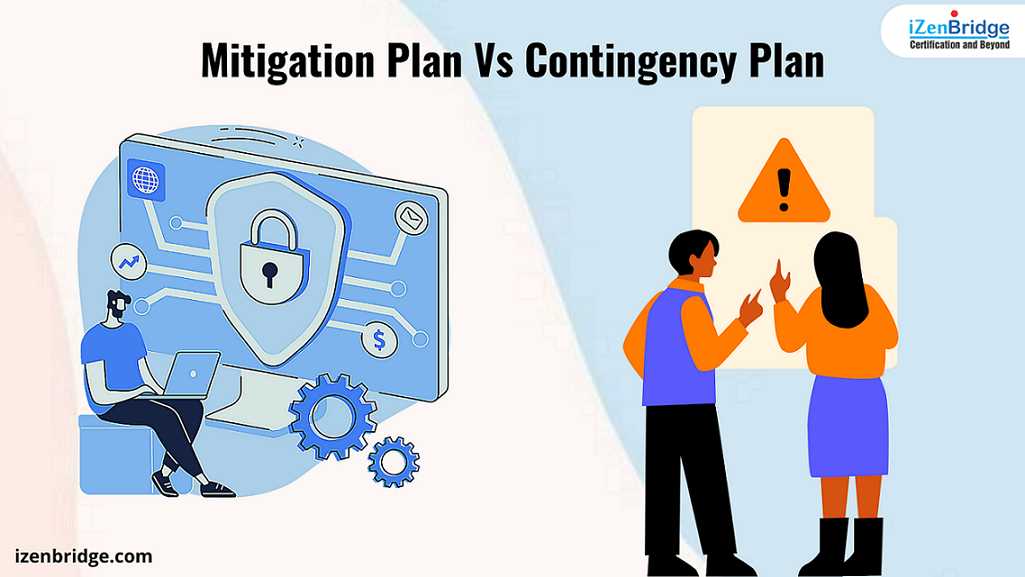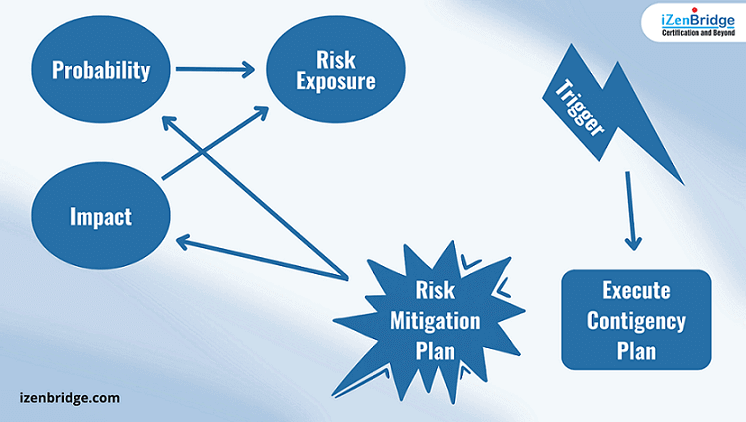

Successful project management relies heavily on the project manager and the team’s ability to identify and respond effectively to threats or negative risks. In our previous blog, “How To Handle Negative Risks – Learn Negative Risk Response Strategies,” we explored five strategies for addressing threats: Avoid, Mitigate, Transfer, Accept, and Escalate. Mitigation planning corresponds to the “mitigate” strategy, while contingency plans can be associated with active acceptance or as a backup response strategy for any risk response. This article aims to clarify the differences between risk mitigation and contingency plans, enabling professionals to apply the appropriate strategy in a given situation, improve stakeholder communication, and better understand these terms in the context of the PMP Exam.

Negative risks or threats are uncertain events that may negatively impact project objectives. A risk mitigation plan is a strategy where the project team acts to decrease the probability of occurrence or impact of a threat or negative risk. The objective is to reduce risk exposure within acceptable limits, which is determined by the probability of occurrence and the impact of the risk. Risk mitigation focuses on lowering the likelihood or probability of the risk occurring or minimizing its impact if it does occur.
Risk mitigation strategies emphasize proactive and advanced actions. The project team identifies and calculates the likelihood and impact of risks early in the project lifecycle.
Contingency plans involve risk responses designed for use only if specific events occur. They are executed when certain events take place, acting as a buffer to absorb the impact of unwanted events.
The project team defines warning signs or triggers as cues to execute contingent risk response strategies. When these warning signs emerge, the team implements the risk response strategies. Thus, it is crucial to track and define the triggers for contingency risk response strategies. Many times the contingency plans are based on contingency reserves.
In the event that a risk is on the verge of materializing (with visible risk triggers), the project manager initiates the contingency plan. This action becomes necessary when it is evident that prior risk response measures have been insufficient in preventing the risk from impacting the project’s execution. Contingencies are often maintained as reserves to address such situations.
A contingency reserve is a provision within the project management plan designed to manage cost and/or schedule risks. To effectively establish a reserve, a thorough reserve analysis is required, taking into account the project’s scheduled duration, budget, estimated costs, and funding needs. For instance, additional time may be allocated within the schedule to accommodate unforeseen events, such as delays in material delivery from vendors, unexpected absences, and other disruptions.
By monitoring for early warning signs, project managers can strategically deploy these pre-established reserves to minimize negative consequences and maintain project continuity.
It is a common misconception among Project Management Professional (PMP)® exam candidates that contingency and mitigation risk responses are mutually exclusive. However, it is essential to understand that these strategies can coexist and complement each other in managing risks effectively.
Typically, mitigation strategies are devised first to reduce the probability and/or impact of risks. After implementing these strategies, any remaining risks may be addressed through contingency plans. In certain situations, both mitigation and contingency responses may need to be executed simultaneously.
Consider this example: You must arrive at the airport on time, but there is a risk of a tire blowout en route. As a mitigation strategy, you have a friend follow you in another car, which you can switch to if your tire blows out. This requires an upfront investment, similar to other risk mitigation strategies.
In addition to this mitigation plan, you may allocate extra time as a reserve to account for potential delays for various reasons, including the tire issue. This reserve time represents a contingency plan to handle any remaining risks even after implementing the mitigation strategy.
When risk threshold is high, it is crucial to proactively plan both risk mitigation and contingency measures. Contingency plans, in particular, are developed for risks within an acceptable threshold and which present sufficient warning signs in advance. By monitoring triggers or warning signs, project managers can effectively manage risks using the combined power of mitigation and contingency plans.
| Risk Mitigation Plan | Risk Contingency Plan |
| You identify actions which you will take in advance irrespective of the occurrence of risk | You plan actions, but you monitor certain warning signs. You take these actions only when you see the warning signs. |
| You spend time and money in advance for the given risk condition | You do not spend time or money in advance, but you keep them ready and invest them when needed |
| We are expected to mitigate the risks which are outside the risk threshold. By applying a mitigation plan, we reduce the probability of the impact of the identified risk. | By identifying the contingency plan, we do not change the probability or impact of the current risk, but we plan to control the impact as risk event looks like occurring. |
| This works as the first level of defense for the high exposure risks | This works as a fallback plan for high exposure risks. |
Conclusion
In conclusion, understanding the differences between risk mitigation and contingency plans is crucial for effective project management. While risk mitigation plans serve as a proactive approach to minimize the likelihood and impact of risks, contingency plans act as a fallback to address potential consequences when warning signs are detected. By implementing both strategies, project managers can successfully navigate high exposure risks and ensure project success. We invite you to join our PMP Training Program to gain a deeper understanding of these risk management techniques and accelerate your journey towards PMP certification. Don’t miss this opportunity to enhance your skills and become a more competent project management professional.

| Name | Date | Place | – |
| PMP Certification and Training | 15 – 30 November 2025 | Bangalore | More Details |
| PMP Certification and Training | 9 Dec’25 – 7 Jan’26 | Chennai | More Details |